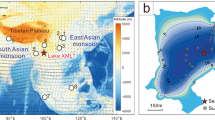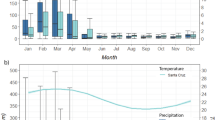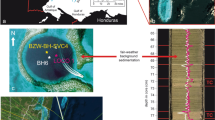Abstract
El Niño events differ substantially in their spatial pattern and intensity. Canonical Eastern Pacific El Niño events have sea surface temperature anomalies that are strongest in the far eastern equatorial Pacific, whereas peak ocean warming occurs further west during Central Pacific El Niño events. The event types differ in their impacts on the location and intensity of temperature and precipitation anomalies globally. Evidence is emerging that Central Pacific El Niño events have become more common, a trend that is projected by some studies to continue with ongoing climate change. Here we identify spatial and temporal patterns in observed sea surface temperatures that distinguish the evolution of Eastern and Central Pacific El Niño events in the tropical Pacific. We show that these patterns are recorded by a network of 27 seasonally resolved coral records, which we then use to reconstruct Central and Eastern Pacific El Niño activity for the past four centuries. We find a simultaneous increase in Central Pacific events and a decrease in Eastern Pacific events since the late twentieth century that leads to a ratio of Central to Eastern Pacific events that is unusual in a multicentury context. Compared to the past four centuries, the most recent 30 year period includes fewer, but more intense, Eastern Pacific El Niño events.
This is a preview of subscription content, access via your institution
Access options
Access Nature and 54 other Nature Portfolio journals
Get Nature+, our best-value online-access subscription
$29.99 / 30 days
cancel any time
Subscribe to this journal
Receive 12 print issues and online access
$259.00 per year
only $21.58 per issue
Buy this article
- Purchase on Springer Link
- Instant access to full article PDF
Prices may be subject to local taxes which are calculated during checkout




Similar content being viewed by others
Data availability
The proxy records with persistent identifier (doi/URL) are listed in Supplementary Table 4. Primary input data are archived by the National Oceanic and Atmospheric Administration (NOAA). Reconstructions are archived at https://www.ncdc.noaa.gov/paleo/study/26270. Additional information and datasets are available at: https://figshare.com/s/0cc010d38b66eb3e7975.
Code availability
The code associated with this paper is available on request from M.B.F.
References
Rasmusson, E. M. & Carpenter, T. H. Variation in tropical sea surface temperature and surface wind fields associated with the Southern Oscillation/El Niño. Mon. Weather Rev. 110, 354–384 (1982).
Kug, J.-S., Jin, F.-F. & An, S.-I. Two types of El Niño events: cold tongue El Niño and warm pool El Niño. J. Climate 22, 1499–1515 (2009).
Ashok, K., Behera, S. K., Rao, S. A., Weng, H. & Yamagata, T. El Niño Modoki and its possible teleconnection. J. Geophys. Res. 112, C11007 (2007).
Larkin, N. K. & Harrison, D. E. Global seasonal temperature and precipitation anomalies during El Niño autumn and winter. Geophys. Res. Lett. 32, L16705 (2005).
Di Lorenzo, E. et al. Central Pacific El Niño and decadal climate change in the North Pacific Ocean. Nat. Geosci. 3, 762–765 (2010).
Yu, J.-Y., Kao, H.-Y., Lee, T. & Kim, S. T. Subsurface ocean temperature indices for Central-Pacific and Eastern-Pacific types of El Niño and La Niña events. Theor. Appl. Climatol. 103, 337–344 (2010).
Graf, H.-F. & Zanchettin, D. Central Pacific El Niño, the ‘subtropical bridge’ and Eurasian climate. J. Geophys. Res. 117, D01102 (2012).
Wang, G. & Hendon, H. H. Sensitivity of Australian rainfall to inter-El Niño variations. J. Climate 20, 4211–4226 (2007).
Taschetto, A. S. & England, M. H. El Niño Modoki impacts on Australian rainfall. J. Climate 22, 3167–3174 (2009).
Cai, W. & Cowan, T. La Niña Modoki impacts Australia autumn rainfall variability. Geophys. Res. Lett. 36, L12805 (2009).
Frauen, C., Dommenget, D., Tyrrell, N., Rezny, M. & Wales, S. Analysis of the nonlinearity of El Niño–Southern Oscillation teleconnections. J. Climate 27, 6225–6244 (2014).
Fedorov, A. V. & Philander, S. G. Is El Niño changing? Science 288, 1997–2001 (2000).
Ren, H.-L., Jin, F.-F., Stuecker, M. F. & Xie, R. ENSO regime change since the late 1970s as manifested by two types of ENSO. J. Meteorol. Soc. Jpn II 91, 835–842 (2013).
An, S. I. & Wang, B. Interdecadal change of the structure of the ENSO mode and its impact on the ENSO frequency. J. Climate 13, 2044–2055 (2000).
Aiken, C. M., Santoso, A., McGregor, S. & England, M. H. Optimal forcing of ENSO either side of the 1970s climate shift and its implications for predictability. Clim. Dynam. 45, 1–19 (2015).
Trenberth, K. E. & Stepaniak, D. P. Indices of El Niño evolution. J. Climate 14, 1697–1701 (2001).
Ren, H.-L. & Jin, F.-F. Niño indices for two types of ENSO. Geophys. Res. Lett. 38, L04704 (2011).
Henley, B. J. et al. A tripole index for the Interdecadal Pacific Oscillation. Clim. Dynam. 45, 1–14 (2015).
L’Heureux, M. L. Recent multidecadal strengthening of the Walker circulation across the tropical Pacific. Nat. Clim. Change 3, 571–576 (2013).
England, M. H. et al. Recent intensification of wind-driven circulation in the Pacific and the ongoing warming hiatus. Nat. Clim. Change 4, 222–227 (2014).
Lee, T. & McPhaden, M. J. Increasing intensity of El Niño in the central–equatorial Pacific. Geophys. Res. Lett. 37, L14603 (2010).
Yeh, S.-W. et al. El Niño in a changing climate. Nature 461, 511–514 (2009).
McPhaden, M. J. & Zhang, X. Asymmetry in zonal phase propagation of ENSO sea surface temperature anomalies. Geophys. Res. Lett. 36, L13703 (2009).
Wang, B. Interdecadal changes in El Niño onset in the last four decades. J. Climate 8, 267–285 (1995).
Newman, M., Shin, S.-I. & Alexander, M. A. Natural variation in ENSO flavors. Geophys. Res. Lett. 38, L14705 (2011).
Capotondi, A. et al. Understanding ENSO diversity. Bull. Am. Meteorol. Soc. 96, 921–938 (2015).
Weber, J. N. & Woodhead, P. M. Temperature dependence of oxygen-18 concentration in reef coral carbonates. J. Geophys. Res. 77, 463–473 (1972).
Grottoli, A. G. & Eakin, C. M. A review of modern coral δ18O and Δ14C proxy records. Earth Sci. Rev. 81, 67–91 (2007).
Torrence, C. & Webster, P. J. The annual cycle of persistence in the El Niño Southern Oscillation. Q. J. R. Meteorol. Soc. 124, 1985–2004 (1998).
Liu, Y. et al. Recent enhancement of Central Pacific El Niño variability relative to last eight centuries. Nat. Commun. 8, 15386 (2017).
McPhaden, M. J. Playing hide and seek with El Niño. Nat. Clim. Change 5, 791–795 (2015).
Menkes, C. E. et al. About the role of westerly wind events in the possible development of an El Niño in 2014. Geophys. Res. Lett. 41, 6476–6483 (2014).
Chen, D. et al. Strong influence of westerly wind bursts on El Niño diversity. Nature Geoscience 8, 1–8 (2015).
Kao, H.-Y. & Yu, J.-Y. Contrasting Eastern-Pacific and Central-Pacific types of ENSO. J. Climate 22, 615–632 (2009).
Kim, S. T. & Yu, J.-Y. The two types of ENSO in CMIP5 models. Geophys. Res. Lett. 39, L11704 (2012).
Yu, Y., Dommenget, D., Frauen, C., Wang, G. & Wales, S. ENSO dynamics and diversity resulting from the recharge oscillator interacting with the slab ocean. Clim. Dynam. 46, 1665–1682 (2015).
Liu, Z. Y., Vavrus, S., He, F., Wen, N. & Zhong, Y. F. Rethinking tropical ocean response to global warming: the enhanced equatorial warming. J. Climate 18, 4684–4700 (2005).
Latif, M. et al. ENSIP: the El Niño simulation intercomparison project. Clim. Dynam. 18, 255–276 (2001).
Chen, C., Cane, M. A., Wittenberg, A. T. & Chen, D. ENSO in the CMIP5 simulations: life cycles, diversity, and responses to climate change. J. Climate 30, 775–801 (2017).
Rayner, N. A., Parker, D. E. & Horton, E. B. Global analyses of sea surface temperature, sea ice, and night marine air temperature since the late nineteenth century. J. Geophys. Res. 108, 4407 (2003).
Tierney, J. E. et al. Tropical sea surface temperatures for the past four centuries reconstructed from coral archives. Paleoceanography 30, 226–252 (2015).
Emile-Geay, J., Cobb, K. M., Mann, M. E. & Wittenberg, A. T. Estimating central equatorial Pacific SST variability over the past millennium. Part II: reconstructions and implications. J. Climate 26, 2329–2352 (2013).
Li, J. et al. Interdecadal modulation of El Niño amplitude during the past millennium. Nat. Clim. Change 1, 114–118 (2011).
Emile-Geay, J. & Tingley, M. P. Inferring climate variability from nonlinear proxies: application to paleo-ENSO studies. Clim. Past. 11, 2763–2809 (2015).
Schneider, T. Analysis of incomplete climate data: estimation of mean values and covariance matrices and imputation of missing values. J. Climate 14, 853–871 (2001).
Mathys, C. A Bayesian foundation for individual learning under uncertainty. Front. Hum. Neurosci. 5, 39 (2011).
Bishop, C. Pattern Recognition and Machine Learning (Information Science and Statistics) (Springer, New York, 2007).
Daunizeau, J., Friston, K. J. & Kiebel, S. J. Variational Bayesian identification and prediction of stochastic nonlinear dynamic causal models. Physica D 238, 2089–2118 (2009).
Blei, D. M., Kucukelbir, A. & McAuliffe, J. D. Variational inference: a review for statisticians. J. Am. Stat. Assoc. 112, 859–877 (2017).
Cook, E. R., Meko, D. M., Stahle, D. W. & Cleaveland, M. K. Drought reconstructions for the continental United States. J. Climate 12, 1145–1162 (1999).
Krzywinski, M. & Altman, N. Classification and regression trees. Nat. Methods 14, 757–758 (2017).
Yeh, S.-W., Wang, X., Wang, C. & Dewitte, B. On the relationship between the North Pacific climate variability and the Central Pacific El Niño. J. Climate 28, 663–677 (2015).
Acknowledgements
M.B.F., B.J.H, D.J.K. and D.D. were supported by the Australian Research Council (ARC) Centre of Excellence for Climate System Science (CE110001028). B.J.H. is supported through an ARC Linkage Project (LP150100062). B.J.H, N.J.A. and D.D. are supported by the ARC Centre of Excellence for Climate Extremes (CE170100023). H.V.M. acknowledges support from ARC Future Fellowship (FT140100286). N.J.A. acknowledges support from ARC Future Fellowship (FT160100029). D.J.K. is supported by the Earth Systems and Climate Change Hub in the Australian Government’s National Environmental Science Program.
Author information
Authors and Affiliations
Contributions
M.B.F. conceived and designed the study, with input from B.J.H. and D.J.K. M.B.F. led the development of the methods, the analysis and the writing of the manuscript. Expert contributions and oversight came from B.J.H., D.J.K., H.V.M., N.J.A. and D.D. All the authors contributed to discussions that shaped the study and the manuscript.
Corresponding author
Ethics declarations
Competing interests
The authors declare no competing interests.
Additional information
Publisher’s note: Springer Nature remains neutral with regard to jurisdictional claims in published maps and institutional affiliations.
Supplementary information
Supplementary Information
Supplementary discussion, figures and tables.
Rights and permissions
About this article
Cite this article
Freund, M.B., Henley, B.J., Karoly, D.J. et al. Higher frequency of Central Pacific El Niño events in recent decades relative to past centuries. Nat. Geosci. 12, 450–455 (2019). https://doi.org/10.1038/s41561-019-0353-3
Received:
Accepted:
Published:
Issue Date:
DOI: https://doi.org/10.1038/s41561-019-0353-3
This article is cited by
-
Enhanced North Pacific Victoria mode in a warming climate
npj Climate and Atmospheric Science (2024)
-
Superiority of a Convolutional Neural Network Model over Dynamical Models in Predicting Central Pacific ENSO
Advances in Atmospheric Sciences (2024)
-
Different El Niño Flavors and Associated Atmospheric Teleconnections as Simulated in a Hybrid Coupled Model
Advances in Atmospheric Sciences (2024)
-
Remote and Local Environmental Factors Drive Long-Term Trends of an Estuarine-Dependent Marine Fish in a Subtropical Coastal Lagoon
Estuaries and Coasts (2024)
-
Nonstationary modulation of the preceding spring North Pacific Victoria mode on the connection of central North America winter temperature with ENSO
Climate Dynamics (2024)



